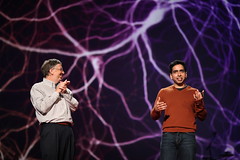 Image by jurvetson via FlickrOne math resource that has gotten an increasing amount of attention in the past year is the Khan Academy. Created by MIT grad Salman Khan, the Khan Academy currently boasts a collection of nearly 2,500 Math and Science video tutorials. His videos have been viewed on YouTube over 73 million times and are used by students, tutors, and math instructors around the World. Khan Academy has been featured on NPR, CNN, and PBS to name a few, and Bill Gates uses the videos with his kids. This is quite a mark made by a nonprofit led by one individual, but what is it about Khan Academy that leads to this kind of attention?
Image by jurvetson via FlickrOne math resource that has gotten an increasing amount of attention in the past year is the Khan Academy. Created by MIT grad Salman Khan, the Khan Academy currently boasts a collection of nearly 2,500 Math and Science video tutorials. His videos have been viewed on YouTube over 73 million times and are used by students, tutors, and math instructors around the World. Khan Academy has been featured on NPR, CNN, and PBS to name a few, and Bill Gates uses the videos with his kids. This is quite a mark made by a nonprofit led by one individual, but what is it about Khan Academy that leads to this kind of attention?Kirk: Khan... Khan, you've got Genesis, but you don't have me. You were going to kill me, Khan. You're going to have to come down here. You're going to have to come down here! Khan: I've done far worse than kill you, Admiral. I've hurt you. And I wish to go on hurting you. I shall leave you as you left me, as you left her; marooned for all eternity in the center of a dead planet... buried alive! Buried alive...!
Kirk: KHAAANNNN!
Perhaps it isn't quite this dramatic, but while some math educators embrace Khan Academy - others discount its influence. Of all the disciplines, I think math instructors are known as the most traditional. Upon closer look, Salman Khan's instructional approach isn't that different from what you would find in the classroom setting. Instead of a chalk or whiteboard, he uses a Smooth Draw writing pad with a black background. His diagrams and notes are all done by hand in different fluorescent colors. There are presentation tools available that are much better than his crude script. He is clearly a remarkably intelligent individual but what is it that makes his work stand out?
It's the technology - or rather, how it is used. The origin of Khan's tutorials came from his desire to help relatives and friends more efficiently, so he posted them on YouTube. Now he could create the tutorials when he had the time and his students could view them when they wanted. The online distribution alone provides an individualized instruction through its convenience.
Online videos can not only be shared, but they can be paused, downloaded, and linked to. Perhaps the college professor doesn't have the freshman's full attention in math class. The student may be tired, doodling cartoons, or thinking about the girl across the room. With Khan as his instructor, he can watch the video later. He can stop it to answer the phone, and he can replay it as many times as he needs to until he understands the epsilon delta limit.
The other thing that Salman Khan provides with technology is a vast catalog of topics in different subject areas. Enter a search term and you should find a video or several videos on the concept. Having the familiarity of the same instructor helps as well, I think, or perhaps he provides a different instructional viewpoint from what is found in the classroom. He has said that he envisions his teachings as a 1:1 experience and this comes through in the videos also. Technology has provided millions of students their own personal tutor.
What I hope Khan's greatest legacy is that he has created the influence necessary to force textbook publishers to digitize. Some math professors have decided to go without textbooks, and rely on Khan Academy to supplement their instruction. The technology has existed for some time, so perhaps it is only the profit margin that has prevented a widespread adoption of this. Khan Academy proves that valuable instruction can be provided globally in a cost efficient manner, conveniently with technology.






